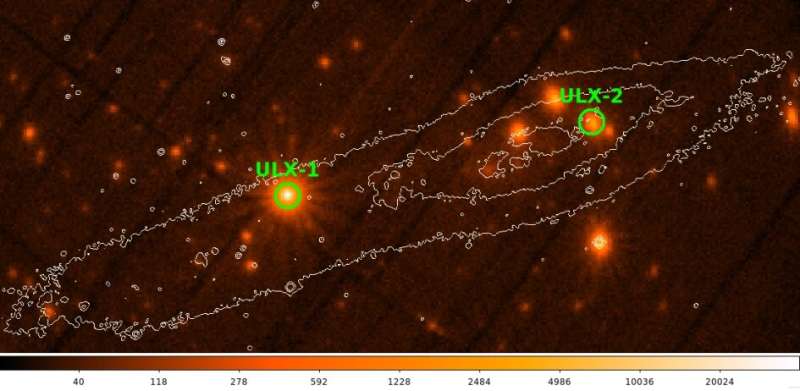July 26, 2022 report
New ultraluminous X-ray source detected in galaxy NGC 55

Using ESA's XMM-Newton and NASA's Swift space telescopes, an international team of astronomers have observed a nearby galaxy known as NGC 55. They discovered a new transient ultraluminous X-ray source in this galaxy. The finding is reported in a paper published July 19 on the arXiv pre-print server.
Ultraluminous X-ray sources (ULXs) are point sources in the sky that are so bright in X-rays that each emits more radiation than 1 million suns emit at all wavelengths. They are less luminous than active galactic nuclei, but more consistently luminous than any known stellar process. Although numerous studies of ULXs have been conducted, the basic nature of these sources remains unsolved.
Located some 6.5 million light years away, NGC 55 (dubbed The Whale Galaxy) is one of the closest galaxies to the Local Group. Its mass is estimated to be about 20 billion solar masses. Previous observations of NGC 55 with XMM-Newton have revealed that it hosts at least one ULX.
Now, a group of astronomers led by Alessandra Robba of the University of Palermo in Italy reports the detection of another ULX in NGC 55. They found that an object, designated XMMU J001446.81-391123.48 and classified as a transient X-ray source, reaches a luminosity peak that allows it to be reclassified as a ULX.
"In this work, we provide evidence for a new (the second) ULX in the galaxy NGC 55, thanks to recent XMM-Newton observations," the researchers wrote in the paper.
New deeper XMM-Newton observations allowed Robba's team to find that XMMU J001446.81-391123.48 reaches a luminosity peak higher than 1.6 duodecillion erg/s. Therefore, the source was confirmed as a ULX and received designation NGC 55 ULX-2.
The researchers noted that taking into account the transient nature of some ULXs, the newly discovered ones are not always new sources. NGC 55 ULX-2 is a good example that in some cases, such sources are detected with luminosity lower than 1 duodecillion erg/s before reaching the ULX regime.
The study found that unlike many transients, characterized by a hard spectrum, NGC 55 ULX-2 has a soft spectrum. The astronomers added that the X-ray spectrum of ULX-2 is much softer than in previous observations and was classified by them as a soft ULX.
According to the research, the temporal behavior of NGC 55 ULX-2 shows that the time scales of the flux variations are of the order of a month. This is most likely due to small changes in the accretion rate or due to super-orbital modulations, attributed to precession of the accretion disk.
The astronomers also performed a deep search for periodic signals from NGC 55 ULX-2. However, no significant coherent signals were detected from this source.
More information: A. Robba et al, A transient ultraluminous X-ray source in NGC 55. arXiv:2207.09447v1 [astro-ph.HE], arxiv.org/abs/2207.09447
© 2022 Science X Network




















